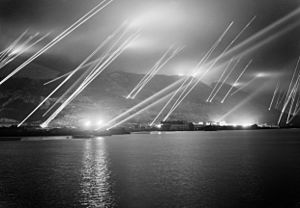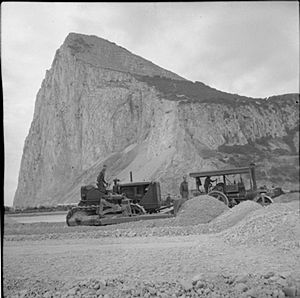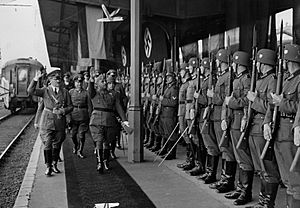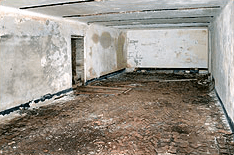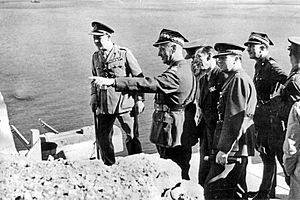Military history of Gibraltar during World War II facts for kids
Gibraltar played a super important role in World War II. It's a British fortress that has been around since the 1700s. It was a key spot for the British military.
Gibraltar is located at the entrance to the Mediterranean Sea. This meant it could control almost all ships going in and out. It was a vital base for the British Navy.
A special group of ships called Force H was based there. They helped keep the seas safe and protected convoys. Convoys were groups of ships carrying supplies. They often went to the island of Malta, which was under attack.
During the war, Gibraltar was bombed by planes from Vichy France and Italy. Italian frogmen also attacked ships in the harbor using special mini-submarines. These frogmen were based on a ship in nearby Spain. German agents also tried to cause trouble.
Inside the famous Rock of Gibraltar, many miles of tunnels were dug. This created an "underground city." It had places for soldiers to live, offices, and even a hospital.
A huge Allied invasion called Operation Torch was planned from Gibraltar in 1942. General Dwight D. Eisenhower led this operation. After the Allies won in North Africa, Gibraltar became a supply base. It continued to help ships until the end of the war in 1945.
Contents
- Life in Gibraltar During the War
- Air Force Operations
- Threats from Spain
- Vichy French Air Raids
- German Plans to Capture Gibraltar
- Italian Bombing Raids
- Italian Frogmen Attacks
- Sabotage from Spain
- Operation Tracer: A Secret Mission
- U-boat Campaign in the Mediterranean
- North African Campaign
- Death of Władysław Sikorski
- After the War
- See also
Life in Gibraltar During the War
World War II changed everything for the people of Gibraltar. Most civilians had to leave their homes. This was so more soldiers and sailors could use the "Rock."
About 13,500 people were sent to Casablanca in French Morocco in 1940. But France then surrendered to Germany. The new French government, called Vichy France, didn't want the Gibraltarians there.
British ships arrived to take French soldiers rescued from Dunkirk back home. These ships were then used to move the Gibraltarian evacuees. The British fleet had just attacked French warships to stop them from falling into German hands. This made things very tense.
Families were forced onto the ships at bayonet point. They could only take what they could carry. When they arrived back in Gibraltar, the Governor wouldn't let them land. He feared it would be too hard to evacuate them again.
People in Gibraltar protested, and eventually, the evacuees were allowed to land. But they had to promise to leave again when new ships arrived. By July 13, they were back on the Rock.
The British government agreed to take the evacuees to the United Kingdom. But there wasn't enough space. About 2,000 people were sent to Madeira, a Portuguese island. The rest, about 10,000, went to the London area.
People in Gibraltar worried as London was heavily bombed. Letters from the evacuees described difficult living conditions. Later, some evacuees were sent to Jamaica in the Caribbean. By the end of 1940, many were in London, some in Jamaica, and a few in Madeira.
Air Force Operations
Work on a solid runway for planes began in 1939. In 1940, they planned to make it even longer. Land was reclaimed from the sea in late 1941 to build the new airfield. This is now Gibraltar International Airport.
The Royal Air Force (RAF) sent a squadron to Gibraltar in September 1939. They were worried about German submarines in the Strait of Gibraltar. These submarines might use Spanish ports.
A special RAF group was formed in 1939 to control air units in Gibraltar. This group later joined the Coastal Command. A combined headquarters was set up in early 1942.
Threats from Spain
In June 1940, Spanish leader Francisco Franco offered to join Germany in the war. In July 1940, Franco said Spain had two million soldiers ready to take Gibraltar back.
But Spain soon realized how well-defended Gibraltar was. They also worried about how a blockade of Spanish ports would hurt their economy. So, Spain decided not to join the war with Germany.
Vichy French Air Raids
On July 18, 1940, Vichy France bombed Gibraltar. This was a response to a British attack on the French fleet. Not much damage was done, but it caused the first injuries. The attack seemed half-hearted, with most bombs missing their target on purpose.
On September 24, 1940, French planes attacked Gibraltar again. One hundred twenty French aircraft from Morocco were reported to have attacked. The Vichy French government ordered this bombing.
Six bomber squadrons from the Vichy French Air Force and four from the Vichy French Navy took part. The 64 bombers flew from bases in Algeria and Morocco. Germany and Italy approved this French action.
The French dropped 150 bombs on Gibraltar. They caused heavy damage to the fortress. The South Mole (a pier) and a large ship were badly hit. Fires started in the northern part of Gibraltar. But again, most bombs fell into the sea.
On September 25, the French returned with 83 bombers. They wanted to cause more damage to the naval base. British planes did not appear. However, the French faced heavy anti-aircraft fire. One bomber was lost, and 13 others were slightly damaged. A British armed trawler, HMT Stella Sirius, was sunk, and several civilians died.
Vichy France said these bombings would continue if Britain kept attacking Dakar. But the attack on September 25 was the last one by Vichy forces on Gibraltar.
German Plans to Capture Gibraltar
Gibraltar survived the war mostly unharmed. But Nazi Germany had plans to capture it. This plan was called "Operation Felix." Adolf Hitler himself approved it.
The plan was for Germany to enter Spain and attack Gibraltar. This would push the British out of the Western Mediterranean. The Strait of Gibraltar would then be closed to the Allies. This would force Allied ships going to Asia to sail all the way around Africa.
German planes would heavily bomb the Rock. Then German troops would attack to take it. This was to prevent Spain from capturing the base.
However, diplomatic talks failed. Hitler and Franco met but couldn't agree. So, the operation, planned for early 1941, never happened.
Later, the plan was changed to "Operation Felix-Heinrich." German troops would be moved from the Soviet Union to capture Gibraltar. But Franco still refused, and the operation was finally cancelled.
Italian Bombing Raids
Italian bombers, called Piaggio P.108s, attacked Gibraltar several times from Sardinia. Most of these attacks happened in 1942. The last raids were during the Allied invasion of Algeria in 1942.
The "274th Long-Range Bombardment Squadron" was the only Italian unit to fly these bombers. They started flying missions in June 1942. Their most famous raids were in October 1942, when they attacked Gibraltar at night.
After Italy surrendered in 1943, the German-allied Italian Social Republic still launched two raids on Gibraltar in June 1944.
| Date | Unit | Bomber | Number |
| 17/18 July 1940 | Experimental Unit | SM.82 | 3 |
| 25/26 July 1940 | Experimental Unit | SM.82 | 3 |
| 20/21 August 1940 | Experimental Unit | SM.82 | 2 |
| 6 June 1941 | Experimental Unit | SM.82 | 1 |
| 11 July 1941 | SM.82 | 1 | |
| 13 July 1941 | SM.82 | 1 | |
| 14 July 1941 | SM.82 | 1 | |
| 1 April 1942 | 47th Squadron | SM.82 | 3 |
| 28/29 June 1942 | 274th Long-Range Bombardment Squadron | P.108B | 5 |
| 3 July 1942 | 274th Long-Range Bombardment Squadron | P.108B | 1 |
| 24 September 1942 | 274th Long-Range Bombardment Squadron | P.108B | 2 |
| 20 October 1942 | 274th Long-Range Bombardment Squadron | P.108B | 4 |
| 21 October 1942 | 274th Long-Range Bombardment Squadron | P.108B | 3 |
| 19 July 1943 | 132nd Torpedo Bomber Group | SM.79 | 10 |
Italian Frogmen Attacks
The "Decima Flottiglia MAS" was an Italian commando unit of frogmen. They carried out many attacks against the harbor at Gibraltar. They called Gibraltar the "Floating Trojan Horse."
Gibraltar was a tempting target for the Italians. It was a safe place for British warships and supply ships. The Italian frogmen first used a Spanish villa near Gibraltar. Later, they moved their base to an Italian tanker ship, the SS Olterra, which was docked nearby.
| Date | Events of the Decima Flottiglia MAS in Gibraltar |
|---|---|
| 21 August 1940 | The Italian submarine Iride left Italy to attack Gibraltar. |
| 24 September 1940 | The Italian Submarine Sciré carried three manned torpedoes. The attack was called off because the British fleet had left Gibraltar. |
| 21 October 1940 | The Sciré went to Gibraltar with three manned torpedoes. Only one entered the harbor, but it didn't damage any ships. Two frogmen were captured, and four escaped to Spain. |
| 25 May 1941 | The Sciré left with three manned torpedoes. They found no warships in Gibraltar. An attack on merchant ships failed. The crews escaped to Spain. |
| 10 September 1941 | The Sciré sank three ships: two tankers and a cargo ship. The torpedo crews swam to Spanish territory and returned to Italy. |
| July 1942 | Italian frogmen set up a base in the Italian cargo ship Olterra. It was docked near Gibraltar. |
| 13 July 1942 | 12 Italian frogmen swam into Gibraltar harbor. They set explosives and sank four freighters. |
| 15 September 1942 | Italian frogmen sank the steamship Ravens Point. |
| 8 December 1942 | Six Italians on three torpedoes attacked British warships. A British patrol boat killed two frogmen. Another torpedo was captured. |
| 8 May 1943 | Three Italian manned torpedoes attacked Gibraltar in bad weather. They sank an American ship and two British freighters. |
| 3 August 1943 | Three Italian manned torpedoes attacked Gibraltar again. They sank three more merchant ships. |
Sabotage from Spain
German agents recruited Spanish and Gibraltarian people to carry out sabotage. These agents used limpet mines to attack ships. The German intelligence service, the Abwehr, set up a network of saboteurs.
Most of the people recruited were Spanish. They were offered money, or sometimes threatened, to join. British intelligence believed at least 183 people were involved in spying and sabotage.
The first attempts at sabotage in early 1941 were not successful. A bomb didn't work, and another blew up near the airfield. In June 1941, British intelligence stopped an attempt to attach a mine to a ship.
In January 1942, two Spanish agents destroyed two aircraft at the airfield. The Spanish saboteurs also sank a British armed trawler, HMT Erin. They also destroyed an auxiliary minesweeper, HMT Honju. This caused the deaths of seven British crew members.
British intelligence worked to stop these operations. In March 1942, a Gibraltarian agent named José Key was arrested. He was executed later that year. By September 1942, the main saboteur, Plazas, resigned.
In March 1943, an ammunition dump was blown up by agents. The British became suspicious and banned some saboteurs from Gibraltar. A Spanish worker, José Martín Muñoz, caused an explosion and fire at a fuel tank in June 1943. He was arrested in August and executed in January 1944.
Eventually, the sabotage activities around Gibraltar stopped.
Operation Tracer: A Secret Mission
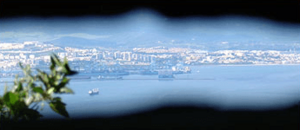
Operation Tracer was a top-secret British spying mission. It would only happen if Gibraltar was captured by the Axis Powers. Six men would be sealed in a cave with supplies for seven years.
These volunteers included two doctors, three signalmen, and their leader. They would watch the harbor through a small slit. They would also have a hidden outdoor terrace. Their job was to send all ship movements to the British Admiralty.
They were told there would be no way out. If anyone died, their body would be preserved and cemented into the floor.
Work on this secret observation post began in late 1941. The site was at Lord Airey's Battery on the Rock. They tested equipment and thought carefully about the kind of men needed. A survival expert advised on diet, exercise, and mental health.
The team was ready by late summer 1942. Their cave was fully equipped. But Operation Tracer was never needed. Adolf Hitler focused his attention on the Eastern Front instead of Gibraltar.
The operation was a mystery for many years. In 1997, the "Stay Behind Cave" was found in Gibraltar. It had been sealed for over 50 years. In 2006, one of the last living members of Operation Tracer, Dr. W. A. Bruce Cooper, shared his memories.
U-boat Campaign in the Mediterranean
The Mediterranean U-boat Campaign took place from 1941 to 1944. The German Navy (Kriegsmarine) tried to cut off Gibraltar, Malta, and Suez. They wanted to disrupt Britain's trade routes.
More than sixty German U-boats were sent to stop Allied shipping. Many of these U-boats were attacked while trying to get through the Strait of Gibraltar. Nine U-boats were sunk, and ten more were damaged.
North African Campaign
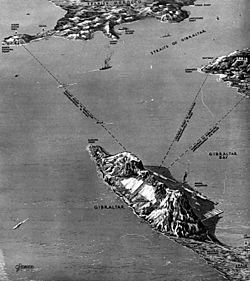
By mid-1942, the Allies were planning a counter-attack. Invading Europe in 1943 seemed too hard. So, they decided to attack the "soft underbelly of Europe" through the Mediterranean. This was Prime Minister Winston Churchill's idea.
The plan was called Operation Torch. It was to occupy French North Africa: Morocco, Algeria, and Tunisia. From there, they could attack Italy and force it out of the war.
In July 1942, General Dwight D. Eisenhower was put in charge of Operation Torch. Churchill placed Gibraltar under Eisenhower's command. It became the temporary headquarters for this big Anglo-American operation.
General Eisenhower arrived in Gibraltar on November 5, 1942. He stayed at The Convent, the Governor's home. But his main headquarters were in a small room inside the Rock's tunnels.
He wrote about the tunnels being dark and damp. The air was heavy, and water constantly dripped from the ceiling. It was a long, tense wait before the operation began.
One hundred thousand soldiers arrived in Gibraltar on many ships. Over 400 aircraft were packed onto the runway. Fighters were shipped in crates and put together at the airfield. All storage areas were filled with supplies.
On November 8, 1942, 466 aircraft from Gibraltar landed on captured North African airfields. From Gibraltar, General Eisenhower and Admiral Sir Andrew Browne Cunningham directed Operation Torch. This was the first major combined operation of the war involving American and British forces.
War Tunnels of Gibraltar
Gibraltar was a small town with few defenses. So, a huge network of tunnels was built inside the Rock of Gibraltar. This "town" inside the Rock had its own power station, water, and hospital. Some soldiers stayed underground for months.
Two Canadian and five British engineer companies dug about 30 miles (48 km) of tunnels. This was an amazing feat at the time. The tunnels were big enough to hold all 30,000 troops on the Rock. Today, Gibraltar has more tunnels than roads.
Death of Władysław Sikorski
On July 4, 1943, a bomber plane took off from Gibraltar for England. On board was General Władysław Sikorski. He was the Prime Minister of Poland's government in exile. He was also the Commander-in-Chief of its armed forces. He was returning from visiting Polish troops.
The plane took off normally but then suddenly lost height. It crashed into the harbor. General Sikorski, 62 years old, died along with 15 others. The only survivor was the pilot, Eduard Prchal. He was rescued by an RAF boat. The bodies of five passengers, including Sikorski's daughter, were never found.
General Sikorski's coffin was covered with the Polish flag. It lay in state in the Cathedral of St. Mary the Crowned. After a service, the bodies were carried to the Dockyard with full military honors. They were shipped to London. The plan was to return General Sikorski's remains to a free Poland one day.
Investigation into the Crash
In 1943, a British investigation looked into the crash. They could not find the exact cause. They only said it was an accident and the plane became uncontrollable. Some thought it was due to poor maintenance.
But because of the political situation and strange events, many people wondered if it was an accident. Some thought it might have been a conspiracy by the Soviets, British, or even Poles.
After the War
After Italy surrendered in September 1943, there were no more reasons to keep the evacuees away. A board was set up in November to help people return. On April 6, 1944, the first group of 1,367 people arrived back from the United Kingdom.
By the end of 1944, only 520 evacuees were left in Madeira. In London, some Gibraltarians were moved to Scotland and Northern Ireland. The Governor fought for the evacuees to return home. But as late as 1947, 2,000 people were still in camps in Northern Ireland. The last evacuees did not return to Gibraltar until 1951.
See also
 In Spanish: Gibraltar en la Segunda Guerra Mundial para niños
In Spanish: Gibraltar en la Segunda Guerra Mundial para niños


